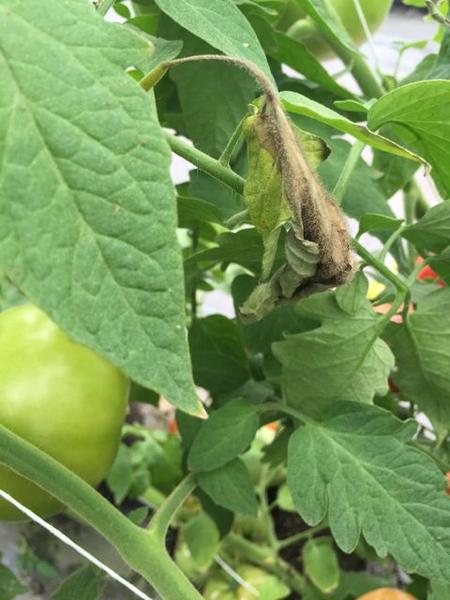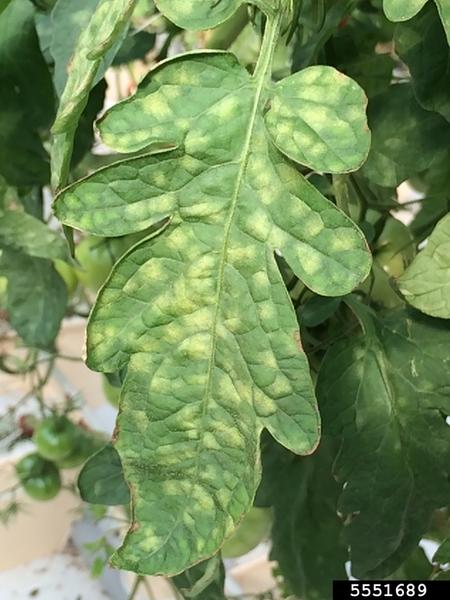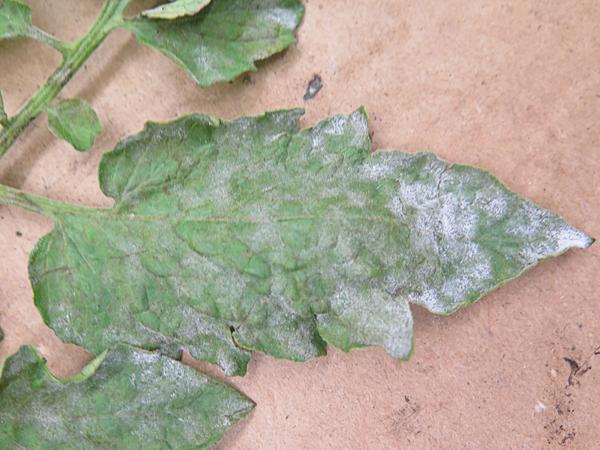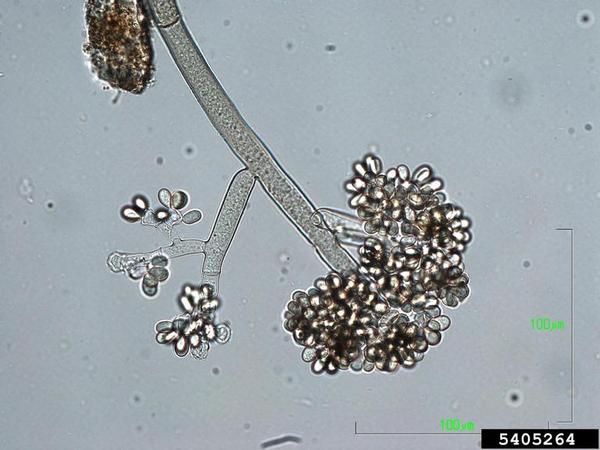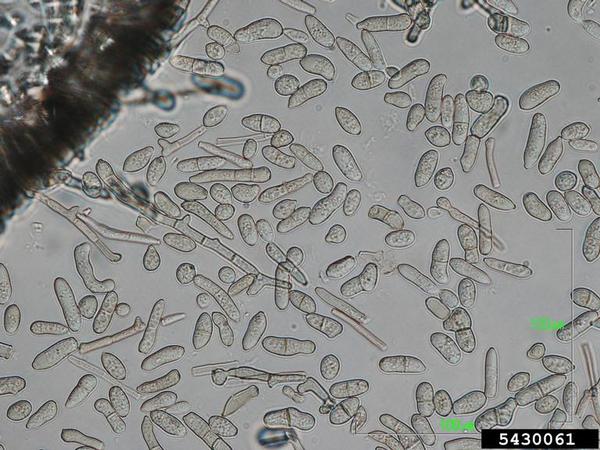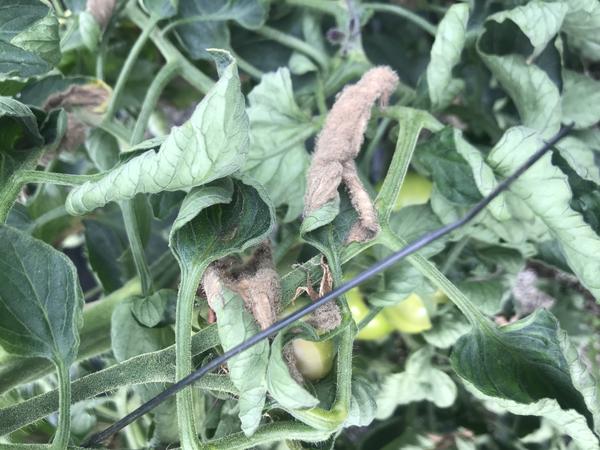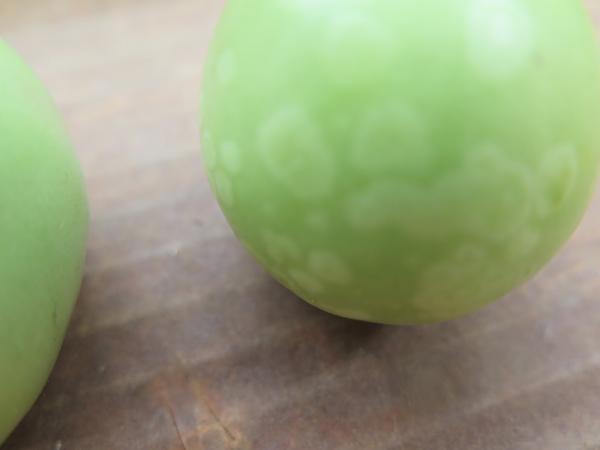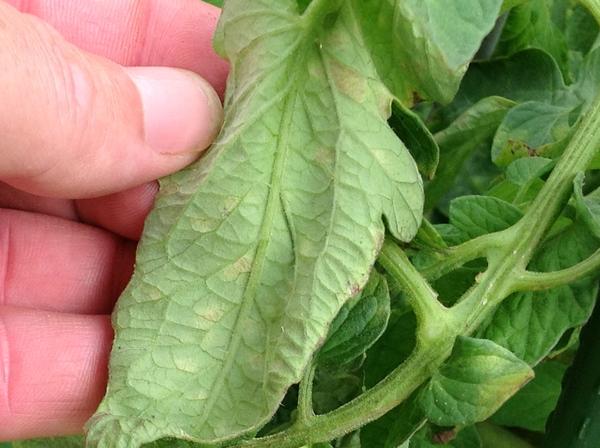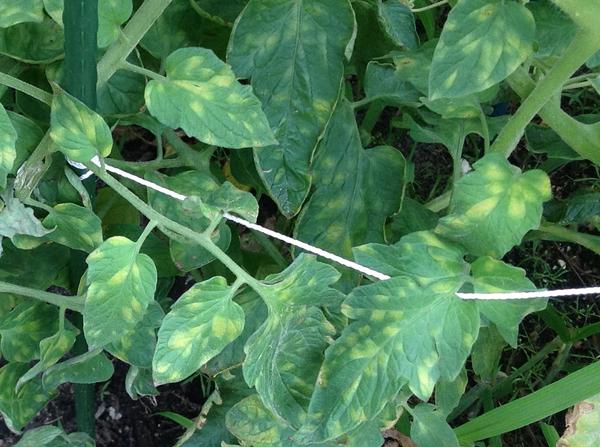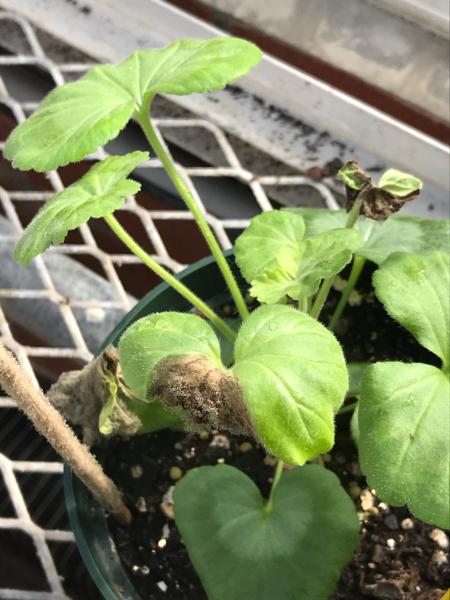General Information
Production of tomatoes in protected environments, such as greenhouses and high tunnels, has gained in popularity in the last decade and requires a different approach to disease management than field production. Diseases such as bacterial spot and speck, Septoria leaf spot, and early blight are easier to manage in greenhouses and high tunnels because plants are protected from heavy rainfall events, which promotes these diseases. However, these structures are prone to high humidity and tend to be wind free, which can encourage disease problems that are uncommon in field production such as leaf mold and powdery mildew. Cool temperatures are conducive for Botrytis gray mold development and are common during spring greenhouse and high tunnel production.
Pathogens
Gray mold is caused by the fungal pathogen Botrytis cinerea. Notable vegetable high tunnel host crops include tomato, pepper, lettuce, and cucumber.
Leaf mold is caused by the fungal pathogen Passalora fulva (syn. Fulvia fulva). Notable vegetable high tunnel host crops include tomato, pepper, and eggplant.
Powdery mildew on tomato can be caused by three different fungal pathogens Leveillua taurica, Oidium neolycopersici, and O. lycopersici. Notable vegetable high tunnel host crops include tomato, pepper, and eggplant.
Symptoms and Signs
Gray Mold can occur on all aboveground plant tissue. The most characteristic sign of gray mold is the profuse fuzzy, gray-brown growth of conidiophores (spore-bearing structures) from necrotic plant tissue. Lesions on leaflets will expand to cover the whole leaflet, to the petiole, and finally the stem. Stem lesions may girdle the stem and cause wilting above the lesion. Stem lesions are the primary cause of plant death in high tunnels. On fruit, B, cinerea causes typical soft rot symptoms and decayed areas are whitish in color, which may contain sporophores. B. cinerea can also produce ghost spots characterized as necrotic flecks surrounded by whitish halos that are 3 to 8 mm in diameter on the fruit. Ghost spots result from aborted infections by spores of B. cinerea and typically occur on mature-green fruit.
Gray mold lesions can be confused with lesions caused by other fungi, damage caused by high salt content in the soil, or wind damage. Gray mold can be distinguished from other disorders by the presence of conidiophores on the surface of diseased, necrotic areas, although spores may not always be present. Spore clouds can be shaken from the conidiophores after prolonged periods. Spores (conidia) are colorless, single celled, ovoid, and are 7.3 x 8.0 to 9.7 x 11.1 µm in size.
Leaf mold primarily occurs on the foliage, but may spread in some cases to the petioles, stems, blossoms, and fruit. Older leaves are affected first and then the younger leaves. Leaf mold initially appears as pale-green or yellowish spots on the upper leaf surfaces that later turn yellow. On the underside of leaves, an olive-green mold is associated with the spots. The mold is more dense and deeper in color in the center of the spots. Spots can coalesce (grow together) and kill the foliage when infection is severe. Leaves may curl, wither, and drop from plants. In some cases, green and mature fruit may develop a black, leathery rot on the stem end.
Leaf mold may be confused with Botrytis gray mold, late blight, and powdery mildew. Under a dissecting microscope, P. fulva has a buff to brown and velvety appearance. Under a light microscope, spores can be readily observed in diseased tissue. Conidia are pale to dark brown, have zero to three septa, contain a thickened hilum (microscopic indentation), and are 4-10 x 12-47 µm in size. Conidiophores (spore-bearing structures) of P. fulva are ≤ 200 µm in size, unbranched, and restricted at the base with a broader tip.
As noted earlier, powdery mildew of tomato is caused by three pathogens. The most common symptom of powdery mildew caused by L. taurica is the development of small (≤ 1 cm), irregularly shaped, light-green to bright yellow lesions on the upper leaf surfaces and will first appear on older leaves. Lesions may become necrotic, coalesce, and expand resulting in the death of entire leaflets. A powdery sporulation typically occurs on the undersides of leaves but may occur on both sides under conditions of humidity. In contrast, the most common symptom of powdery mildew caused by species of Oidium is the appearance of white, powdery growths of mycelia and conidia on the upper leaf surface. These areas can coalesce and form dense powdery sporulation over much of the leaf surface. Severely infected leaves can become chlorotic and necrotic.
On infected plant tissue, L. taurica will produce long conidiophores that are often branched with conidia that are either cylindrical or pyriform (pear-shaped) in shape. Conidia can be formed singly or in short chains. Cylindrical conidia are 16-23 x 45-65 µm in size and pyriform conidia are 14-24 x 50-71 µm in size. In contrast, O. neolycopersici produce erect, long, unbranched conidiophores with a single conidium. However, under conditions of high humidity, spores can be produced in chains of two to six. Conidia are ellipsoid-ovoid in shape and are 10-20 x 22-46 µm in size. The morphological characteristics of conidiophores and conidia produced by O. lycopersici are similar to those of O. neolycopersici. However, conidia are formed in chains of three to five.
Disease Cycle and Epidemiology
There are several sources of inoculum for gray mold. B. cinerea has a wide host range and disease can be present on perennial plants in any geographical location. Spores are easily windborne. Sporulation can occur under wet conditions with high humidity (>80%) and moderate temperatures (65 to 75°F). Gray mold begins in relatively cool weather and does not require prolonged periods of high humidity. B. cinerea can survive as a saprophyte on organic matter in the soil. The fungus can also survive from season to season as sclerotia, which form on woody tissues of tomato plants. The fungus will grow from sclerotia or organic matter in the soil and can infect leaves lying on the ground. B. cinerea can infect plant tissue directly or through some type of wound. Thus, use good pruning techniques to avoid excessive damage to plants.
P. fulva, the leaf mold pathogen, needs excess water on foliage or high humidity (>85%) to grow and can cause disease at any temperature ranging from 40 to 94°F. However, disease development is optimal at 72-75°F. P. fulva can survive for at least 1 year as a saprophyte on crop residue and in the soil as conidia or sclerotia. Conidia are spread by wind and rain. The fungus can also be spread from plant to plant via tools and clothing.
The powdery mildew pathogens have a broad host range and can infect several crop and weed species. Weeds and other solanaceous crops can serve as inoculum sources. L. taurica, O. neolycopersici, and O. lycopersici require high relative humidity (75-85%) and can cause disease at any temperature ranging from 50 to 98°F with 70°F being optimal for spore germination. Infection can occur with little or no free moisture under high humidity. Spores are readily windborne and secondary infections also occur under conditions of high humidity.
General Disease Management
Losses from Botrytis gray mold, leaf mold, and powdery mildew can be reduced by adopting the following management strategies:
- Wider plant spacing and improved ventilation can reduce disease incidence. Raise the sides of high tunnels to improve air movement. Use fans to replace the air multiple times per day especially during rainy or cloudy periods. Air movement inhibits Botrytis spores from germinating.
- Remove lower leaves as the plant ages to improve air movement. Suckering below the first flower cluster on tomato plants will promote air circulation, but be sure the particular variety will respond as desired to suckering.
- Manage temperatures to reduce condensation. Fans or tubing can be used to distribute heated air throughout the structure. Heating under the bench can also reduce condensation on the plants and reduce disease.
- Trays, benches, tools, stakes, twine, wire, high tunnel structures, and any other tools should be washed and sanitized between crops.
- Workers should wash hands often—at least at the end of each row—to minimize spread of pathogens.
- Eliminate weeds from the high tunnel. Weeds can harbor diseases that can affect vegetables.
- Scout for disease routinely.
- Remove infected seedlings and diseased tissue.
- Remove and destroy crop residue.
- Place cull piles away from the high tunnel.
- Avoid combining ornamental plants with vegetable production in high tunnels. Some ornamentals can harbor diseases that also affect vegetables.
- Avoid overhead irrigation. Use drip tape or water at the base to reduce moisture on leaves and splash dispersal of pathogens.
- Avoid damaging plants, especially for the prevention of Botrytis gray mold.
- Avoid handling wet plants.
- Crop rotation can reduce disease incidence but can be difficult to achieve in high tunnels. Mobile high tunnels can be moved from one location to another but must be securely anchored to withstand high winds. For immovable structures, crops should be rotated within the high tunnel between plant families.
- Use resistant varieties when possible. For more information on specific varieties please refer to the Southeastern US Vegetable Crop Handbook and Cornell University’s Tomato Variety Tables for more information.
- There are no resistant varieties to Botrytis gray mold.
- Varieties resistant to leaf mold such as ‘Trust,’ ‘Geronimo,’ and ‘Starbuck’ should be used as part of an IPM program. However, there are currently 12 races of P. fulva and each variety only protects against only one to a few races. Currently, it is unknown which P. fulva races are present in North Carolina.
- There are some tomato varieties such as ‘Geronimo’ and ‘Toreo’ that are tolerant to powdery mildew that can be used as a part of IPM program.
Disease Control for Conventional Growers
There are several products that are labeled for use on high tunnel tomatoes for managing Botrytis gray mold, leaf mold, and powdery mildew (Table 1). Not all products listed can be used in the greenhouse; refer to the table for location use. This is not an exhaustive list of all available products, for the latest fungicide recommendations see the Southeastern US Vegetable Crop Handbook. All products provide the best control if applied preventatively. According to the Fungicide Resistance Action Committee (FRAC), B. cinerea has been categorized as a high-risk pathogen due to the development of fungicide resistance and resistance management is required.
|
Active Ingredient |
Example Product |
PHI (days)1 |
FRAC Group2 |
Disease |
Application Interval | Greenhouse Use |
| azoxystrobin | Quadris3 | 0 | 11 | Powdery mildew | Apply on a 7-21 day interval. | Do not use in the greenhouse. |
| azoxystrobin + chlorothalonil | Quadris Opti3 | 0 | 11 + M03 | Powdery mildew | Apply on a 7-21 day interval. | Do not use in the greenhouse. |
| azoxystrobin + difenoconazole | Quadris Top3 | 0 | 11 + 3 |
Leaf mold Powdery mildew |
Apply on a 7-10 day interval. | Not prohibited for greenhouse use. Do not use on transplants. |
| azoxystrobin + flutriafol | Topguard EQ | 0 | 11 + 3 | Powdery mildew | Apply on a 7-21 day interval. | Do not use in the greenhouse. |
| boscalidR | Endura3 | 0 | 7 | Botrytis gray mold | Apply on a 7-14 day interval. | Do not use in the greenhouse. |
| chlorothalonil | various | 0 | M05 |
Botrytis gray mold Powdery mildew |
Apply on a 7-10 day interval for foliage, and 7-14 day interval for fruit. | Do not use in the greenhouse. |
| chlorothalonil + cymoxanil | Ariston | 3 | M05 + 27 | Botrytis gray mold | Apply every 7 days beginning at fruit set. | Do not use in the greenhouse. |
|
cyprodinilR + fludioxonilR |
Switch 62.5 WG3 |
0 |
9 +12 |
Botrytis gray mold Powdery mildew |
Apply on a 7-10 day schedule when conditions are conducive for disease development. | Not prohibited for greenhouse use. |
| difenoconazole + benzovindiflupyr | Aprovia Top3 | 0 | 7 + 3 |
Leaf mold Powdery mildew |
Apply on a 7-14 day interval. | Do not use in the greenhouse. |
| difenoconazole + cyprodinil | Inspire Super3 | 0 | 3 + 9 |
Botrytis gray mold Leaf mold Powdery mildew |
Apply on a 7-10 day interval. | Not prohibited for greenhouse use. |
| difenoconazole + mandipropamid | Revus Top3 | 1 | 3 + 40 |
Leaf mold Powdery mildew |
Apply on a 7-10 day interval. | Not prohibited for greenhouse use. |
| famoxadone + cymoxanil | Tanos3 | 3 | 11 + 27 | Leaf mold | Apply on a 5-7 day interval. | Not prohibited for greenhouse use. |
| flutriafol | Rhyme3 | 0 | 3 | Powdery mildew | Apply on a 7 day interval. | Not prohibited for greenhouse use. |
|
fluopyram + pyrimethanilR |
Luna Tranquility3 |
1 |
7 + 9 |
Botrytis gray mold Powdery mildew |
Apply on a 7-14 day interval. | Greenhouse use allowed. |
| fluopyram + trifloxystrobin | Luna Sensation3 | 3 | 7 + 11 |
Botrytis gray mold Powdery mildew |
Apply on a 7-14 day interval. | Greenhouse use allowed. |
| fluxapyroxad + pyraclostrobin | Priaxor Xemium3 | 7 | 7 + 11 | Botrytis gray mold | Apply on a 7-14 day schedule when conditions are conducive for disease development. | Do not use in the greenhouse. |
|
mancozeb5 |
various |
5 |
M03 |
Leaf mold |
Apply on a 3-7 day interval. | Not prohibited for greenhouse use. |
| mancozeb + azoxystrobin | Dexter Max3 | 5 | M03 + 11 |
Leaf mold Powdery mildew |
Apply on a 7-10 day interval. | Greenhouse use not prohibited. Do not use on transplants. |
| macnozeb + copper hydroxide | ManKocide | 5 | M03 + M01 | Leaf mold | Apply on a 7-10 day interval. | Not prohibited for greenhouse use. |
| mancozeb + zoxamide | Gavel3 | 5 | M03 + 22 | Leaf mold | Apply on a 7-10 day interval. | Not prohibited for greenhouse use. |
| myclobutanil | various | 1 | 3 | Powdery mildew | Do not exceed 21 days between applications. | Do not use in the greenhouse. |
|
penthiopyrad3 |
Fontelis 1.67 SC3 |
0 |
7 |
Botrytis gray mold Powdery mildew |
Apply on a 7-14 day interval. | Greenhouse use allowed. |
| pyraclostrobin | Cabrio EG3 | 0 | 11 |
Botrytis gray mold (suppression only) Powdery mildew |
Apply on a 7-14 day interval. | Do not use in the greenhouse. |
|
pyrimethanilR |
Scala SC3 |
1 |
9 |
Botrytis gray mold |
Apply on a 7-14 day interval. | Greenhouse use allowed. |
|
sulfur4 |
various |
See label |
M02 |
Powdery mildew |
Follow label. | Check label for greenhouse use. |
| tetraconazole | Mettle 125 ME3 | 0 | 3 |
Leaf mold Powdery mildew |
Apply on a 7-14 day interval. | Do not use in the greenhouse. |
| trifloxystrobin | Flint Extra3 | 3 | 11 | Powdery mildew | Apply on a 7-10 day interval. | Do not use in the greenhouse. |
|
tolfenpyrad |
Torac3 |
1 |
39 |
Powdery mildew |
Allow at least 14 days between applications. | Not prohibited in the greenhouse. |
|
1 PHI= preharvest interval |
||||||
Disease Management for Organic Growers
Organic growers should follow the general disease management recommendations above in addition to the products listed below. All products listed are OMRI-approved at the time of this publication. Always check the label for current restrictions.
| Active Ingredient | Product Name | PHI | Group1 | Disease |
|---|---|---|---|---|
|
Bacillus amyloliquefasciens strain MBI 600 |
Serifel |
0 |
44 |
Gray mold Powdery mildew |
|
Bacillus subtilis strain QST 713 |
Serenade ASO Serenade Opti |
0 |
44 |
Gray mold Powdery mildew |
|
Bacillus mycoides isolate J |
LifeGard WG |
0 |
44 |
Gray mold |
| copper (various formulations) | (various) | (see label) | M01 | (see label) |
| extract of Reynoutria sachalinensis | Regalia | 4 hr | P05 |
Gray mold Powdery mildew |
|
potassium bicarbonate4 |
Carb-O-Nator MilStop |
0 |
NC |
Botrytis gray mold Powdery mildew |
| sulfur (various) | (various) | (see label) | M02 | Powdery mildew |
| 1FRAC group (fungicide group) | ||||
Disease Management for Home Owners
Home owners using high tunnels for tomato production should follow the General Disease Management guidelines. For a list of fungicides available to home owners, see UGA Fungicide Guide for Homowners.
Resources
- The NCSU Plant Disease and Insect Clinic provides diagnostics and control recommendations
- The NC State Extension Plant Pathology portal provides information on crop disease management
- The Southeastern US Vegetable Crop Handbook provides information on vegetable disease management
- The USDA Fungus-Host Distributions Database provides information about reported hosts for fungal and oomycete pathogens
Acknowledgments
This disease factsheet was prepared by the Meadows Plant Pathology Lab.
Funding for creating this fact sheet comes from the United States Department of Agriculture (USDA)-National Institute of Food and Agriculture (NIFA) (2017-70006-27141).
Publication date: May 8, 2019
Reviewed/Revised: May 4, 2020
N.C. Cooperative Extension prohibits discrimination and harassment regardless of age, color, disability, family and marital status, gender identity, national origin, political beliefs, race, religion, sex (including pregnancy), sexual orientation and veteran status.
Recommendations for the use of agricultural chemicals are included in this publication as a convenience to the reader. The use of brand names and any mention or listing of commercial products or services in this publication does not imply endorsement by NC State University or N.C. A&T State University nor discrimination against similar products or services not mentioned. Individuals who use agricultural chemicals are responsible for ensuring that the intended use complies with current regulations and conforms to the product label. Be sure to obtain current information about usage regulations and examine a current product label before applying any chemical. For assistance, contact your local N.C. Cooperative Extension county center.
N.C. Cooperative Extension prohibits discrimination and harassment regardless of age, color, disability, family and marital status, gender identity, national origin, political beliefs, race, religion, sex (including pregnancy), sexual orientation and veteran status.

